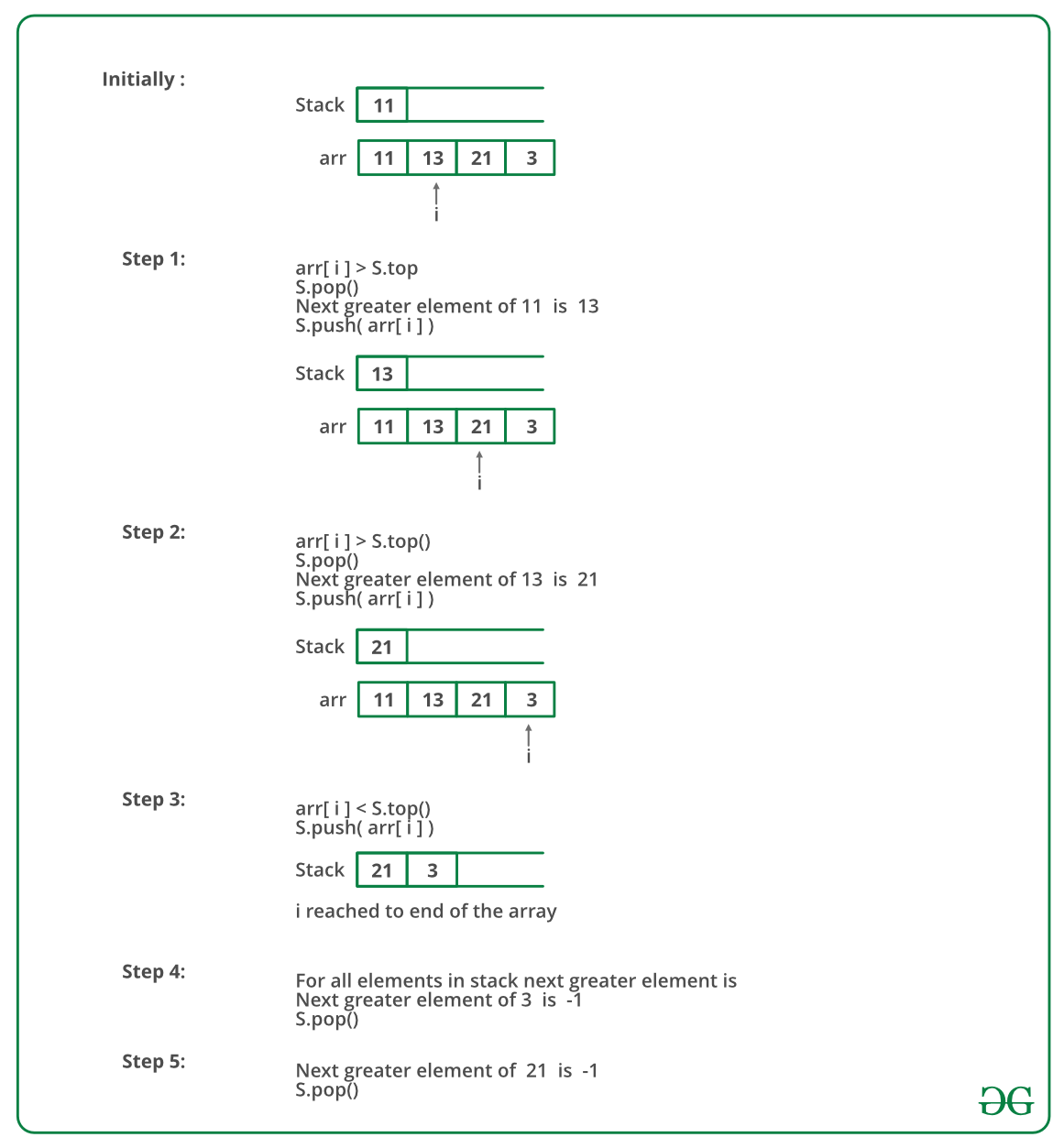C++ Program To Find Next Greater Element
Last Updated :
17 Aug, 2023
Given an array, print the Next Greater Element (NGE) for every element. The Next greater Element for an element x is the first greater element on the right side of x in the array. Elements for which no greater element exist, consider the next greater element as -1.
Examples:
- For an array, the rightmost element always has the next greater element as -1.
- For an array that is sorted in decreasing order, all elements have the next greater element as -1.
- For the input array [4, 5, 2, 25], the next greater elements for each element are as follows.
Element NGE
4 --> 5
5 --> 25
2 --> 25
25 --> -1
d) For the input array [13, 7, 6, 12}, the next greater elements for each element are as follows.
Element NGE
13 --> -1
7 --> 12
6 --> 12
12 --> -1
Method 1 (Simple)
Use two loops: The outer loop picks all the elements one by one. The inner loop looks for the first greater element for the element picked by the outer loop. If a greater element is found then that element is printed as next, otherwise, -1 is printed.
Below is the implementation of the above approach:
C++
#include<iostream>
using namespace std;
void printNGE(int arr[], int n)
{
int next, i, j;
for (i = 0; i < n; i++)
{
next = -1;
for (j = i + 1; j < n; j++)
{
if (arr[i] < arr[j])
{
next = arr[j];
break;
}
}
cout << arr[i] << " -- "
<< next << endl;
}
}
int main()
{
int arr[] = {11, 13, 21, 3};
int n = sizeof(arr)/sizeof(arr[0]);
printNGE(arr, n);
return 0;
}
|
Output
11 -- 13
13 -- 21
21 -- -1
3 -- -1
Time Complexity: O(N2)
Auxiliary Space: O(1)
Method 2 (Using Stack)
- Push the first element to stack.
- Pick rest of the elements one by one and follow the following steps in loop.
- Mark the current element as next.
- If stack is not empty, compare top element of stack with next.
- If next is greater than the top element, Pop element from stack. next is the next greater element for the popped element.
- Keep popping from the stack while the popped element is smaller than next. next becomes the next greater element for all such popped elements.
- Finally, push the next in the stack.
- After the loop in step 2 is over, pop all the elements from the stack and print -1 as the next element for them.
Below image is a dry run of the above approach:

Below is the implementation of the above approach:
C++
#include <bits/stdc++.h>
using namespace std;
void printNGE(int arr[], int n)
{
stack<int> s;
s.push(arr[0]);
for (int i = 1; i < n; i++)
{
if (s.empty()) {
s.push(arr[i]);
continue;
}
while (s.empty() == false
&& s.top() < arr[i])
{
cout << s.top()
<< " --> " << arr[i] << endl;
s.pop();
}
s.push(arr[i]);
}
while (s.empty() == false) {
cout << s.top() << " --> " << -1 << endl;
s.pop();
}
}
int main()
{
int arr[] = { 11, 13, 21, 3 };
int n = sizeof(arr) / sizeof(arr[0]);
printNGE(arr, n);
return 0;
}
|
Output
11 --> 13
13 --> 21
3 --> -1
21 --> -1
Time Complexity: O(N)
Auxiliary Space: O(N)
The worst case occurs when all elements are sorted in decreasing order. If elements are sorted in decreasing order, then every element is processed at most 4 times.
- Initially pushed to the stack.
- Popped from the stack when next element is being processed.
- Pushed back to the stack because the next element is smaller.
- Popped from the stack in step 3 of the algorithm.
How to get elements in the same order as input?
The above approach may not produce output elements in the same order as the input. To achieve the same order, we can traverse the same in reverse order
Below is the implementation of the above approach:
C++
#include <bits/stdc++.h>
using namespace std;
void printNGE(int arr[], int n)
{
stack<int> s;
int res[n];
for (int i = n - 1; i >= 0; i--) {
if (!s.empty()) {
while (!s.empty() && s.top() <= arr[i]) {
s.pop();
}
}
res[i] = s.empty() ? -1 : s.top();
s.push(arr[i]);
}
for (int i = 0; i < n; i++)
cout << arr[i] << " --> " << res[i] << endl;
}
int main()
{
int arr[] = { 11, 13, 21, 3 };
int n = sizeof(arr) / sizeof(arr[0]);
printNGE(arr, n);
return 0;
}
|
Output
11 ---> 13
13 ---> 21
21 ---> -1
3 ---> -1
Time Complexity: O(N)
Auxiliary Space: O(N)
Please see for an optimized solution for printing in same order.
Please refer complete article on Next Greater Element for more details!
Like Article
Suggest improvement
Share your thoughts in the comments
Please Login to comment...